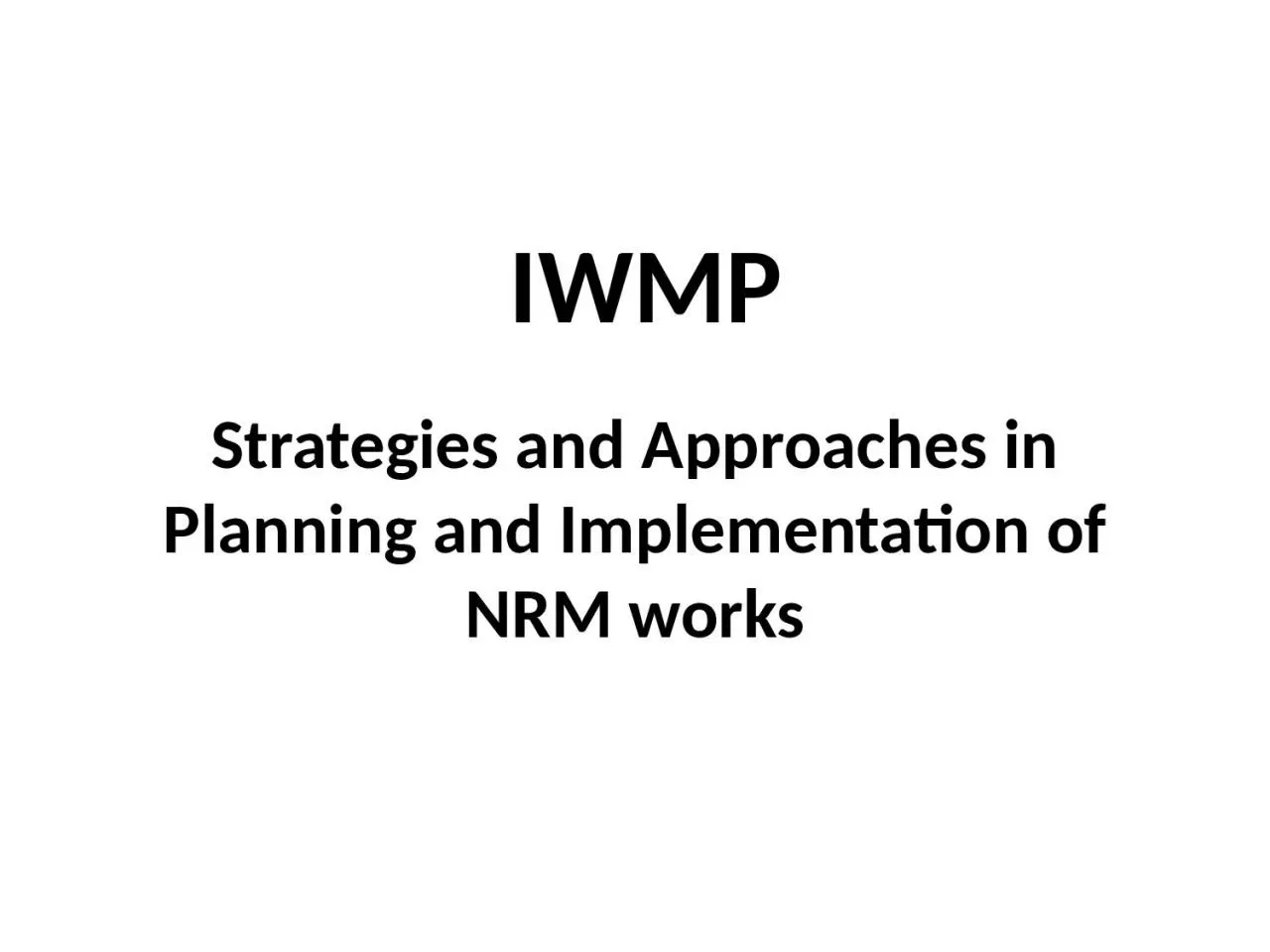

in Planning and Implementation of NRM works NRM Natural Resource Management refers to the management of natural resources such as land water soil plants and animals with a particular focus on how management affects the quality of life for both present and future generations ID: 1024475
Download Presentation The PPT/PDF document "IWMP Strategies and Approaches" is the property of its rightful owner. Permission is granted to download and print the materials on this web site for personal, non-commercial use only, and to display it on your personal computer provided you do not modify the materials and that you retain all copyright notices contained in the materials. By downloading content from our website, you accept the terms of this agreement.
1. IWMPStrategies and Approaches in Planning and Implementation of NRM works
2. NRMNatural Resource Management refers to the management of natural resources such as land, water, soil, plants and animals, with a particular focus on how management affects the quality of life for both present and future generations
3. NRM - ObjectivesTo conserve & rejuvenate natural resource like soil, water & biomassTo protect fertile top soil through micro level scientific interventionsTo reduce the volume & velocity of surface and sub surface runoffTo harvest rainwater so as to replenish the ground water storageTo enhance vegetative cover for mitigating drought
4. To create environment friendly models in development activitiesTo promote & utilise indigenous knowledge and skillsTaking up activities in both private & common lands on a water shed approachConservation of wet lands like ponds, paddy fields, back waters and protection of mangrove forests, sacred groves, springs etc
5. NRM StrategyPlanning & Implementation – Leading role by PRIsParticipatory approach in NRM – Enhanced community participation through WC, UGs & JLGsScientific Planning – use of GIS & Remote SensingRidge to valley approachSite specific interventionsComprehensive development of multiple natural resources based on watershed approach Integrated farming systems based natural resources managementBuilding both natural and social capital simultaneouslyFostering Convergence and Synergy among Programmes Continuous monitoring and evaluation (M&E)
6. NRM PlanningBase Line SurveySocio-Economic conditionsSoil and Land UseAgriculture: crops, yields, horticulture etcProduction/farming systemsLivestock and FisheriesForests and Grass land, ago-forestryLivelihood Status/pattern, sources, dependanceHydrology and Water ResourcesResource conservation and water use
7. Baseline surveyHousehold CensusBaseline SurveyAct as a bench mark of the Project for future evaluation and impact analysis.Collection of socio-economic details with Household survey.Bio-physical survey to collect details of natural resources
8. Bio-physical SurveyNatural Resources Household CensusBio-physical surveyBaseline survey Geo-referenced data collection of particular natural resources.Geo-referenced soil sample collection from representative area.Survey number wise collection of land details about land acreage, ownership, crop cultivated(season), irrigation source and season details.
9. PRA TechniquesLocal KnowledgePRA TechniqueBio-Physical Survey Baseline SurveyHousehold CensusNatural Resources
10. Net PlanningMeeting with local community membersUnderstanding various schemes running in the project area for convergence.Detail Budgeting for each activity to be undertaken under IWMP.Identifying interventions in each single plot of the watershed Group Discussion of activities with -Watershed committee -Farmers(Small, Marginal) & Agricultural labours -Women group -BPL,SC/ST Population
11. Net Planning Activities Planning Net Planning PRA TechniquesBio-Physical surveyBaseline SurveyHousehold CensusNatural Resources Local Knowledge
12. NRM activities envisaged in IWMPAfforestation Staggered trenchingContour and graded bundingBench terracingLand developmentVegetative reinforcementLive fencingMulchingAgro-forestry
13. Drainage line treatment with a combination of vegetative and engineering structuresEarthen checksBrushwood checksGully plugs Loose boulder checksGabion structures Underground dykes
14. Development of water harvesting structures Low-cost farm pondsCheck-dams Percolation tanks/pitsPond RenovationGround water recharge through wells, bore wells, and other measuresRain water harvesting structures
15. NRM ImplementationWorks in common land – by UGsIn private land – by the individual beneficiaries coordinated by beneficiary groupsEstimates by WDT EngineersTS & Check Measurement by LSGD EngineersApproved rates of PWD/Soil Conservation/Agriculture/Forest or Local rates
16. TS & Check Measurement is not required for those works taken up under approved unit costMobilization advance & part payments for UGsWDF for works in private land All financial transactions only with the approval of WCsDocumentation of works in all stagesInformation Boards should be exhibited at worksiteSocial Audit by Grama Sabha